Petrochemical Pollution And Corexit Toxicities From BP Gulf Oil Spill Have Worldwide Implications
SOTN Editor’s Comment:
The BP Gulf oil spill has proven to be the greatest environmental disaster in American history. The far-reaching global repercussions are only now beginning to be understood. Had BP been transparent about the actual amount of oil spilt, much more initiative would have been taken to contain and properly dispose the hydrocarbon effluent that gushed from the Macondo Prospect for 87 memorable days. Likewise, the affected Gulf States could have done much more to minimize the profound impacts to their fragile coastal ecosystems.
Because of the vast Gulf of Mexico coastline, many communities have been profoundly affected to this very day. Beachfront businesses and residences of every kind continue to experience various negative outcomes from the catastrophic oil spill. Given the revelations of the National Geographic special report which follows, the myriad adverse effects — environmental and ecological, economic and financial, medical and social — will likely linger for the rest of our lifetimes. Most are completely unaware, but it is the numerous yet still unknown consequences of BP’s gross negligence which may be the most concerning of all.
Question: After reading this and many other reports just like it, would you eat the seafood coming from the Gulf of Mexico? Or swim in the Gulf? Or walk the GOM tar ball strewn beaches?
~~~~~~~~~~~~~~~~~~~~~~~~~~~~~~~~~~~~~~~~~~~~~~~~~~~~~~~~~~~~~~
How Oil Spills Can Literally Break Fish Hearts
Tiny amounts of Gulf oil, toxic to baby fish, could have worldwide implications, scientists say
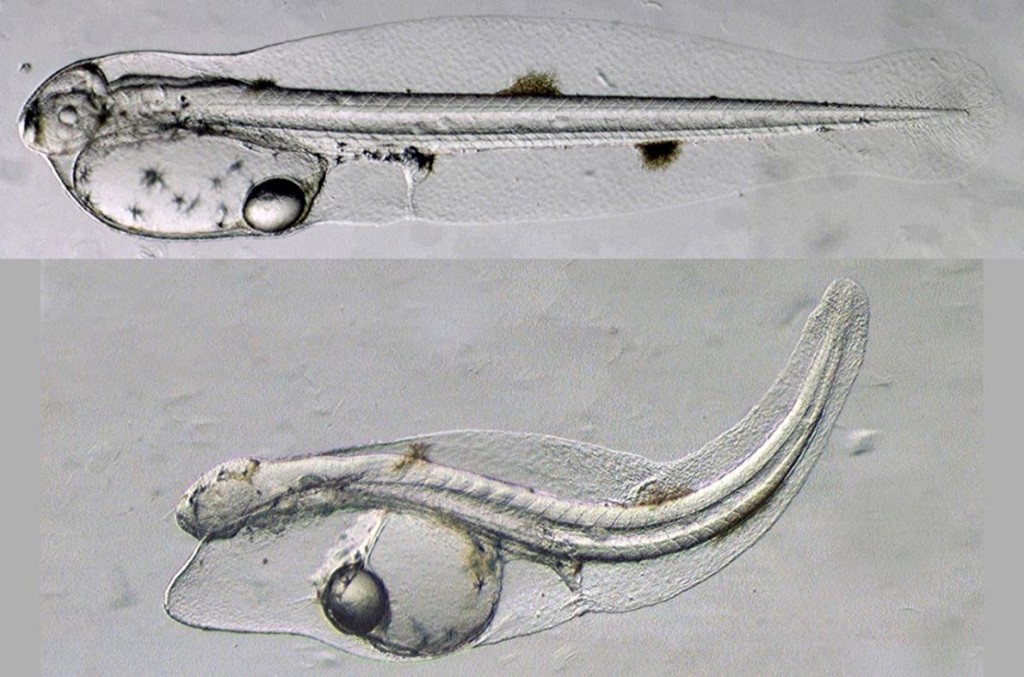 A yellowfin tuna larva unexposed to oil (top) developed normally, while one (bottom) exposed to oil spilled into the Gulf of Mexico by the rig Deepwater Horizon had an array of abnormalities, including heart failure and poor growth of eyes and fins.
A yellowfin tuna larva unexposed to oil (top) developed normally, while one (bottom) exposed to oil spilled into the Gulf of Mexico by the rig Deepwater Horizon had an array of abnormalities, including heart failure and poor growth of eyes and fins.
PHOTOGRAPH BY JOHN INCARDONA, NOAA
By Craig Welch, National Geographic
PUBLISHED APRIL 16, 2015
_________________________________________________________
Editor’s Note: This is the second of four stories marking the fifth anniversary of the Deepwater Horizon oil spill in the Gulf of Mexico.
_________________________________________________________
Oil-slathered birds were a potent symbol of the ecological cost of millions of gallons of oil that flowed into the Gulf of Mexico five years ago. But the less-visible plight of baby fish may offer a more far-reaching legacy.
Lab experiments show that trace amounts of the oil that gushed out of BP’s blown-out well can cause birth defects in minnows, mess up the heart rhythms of young bluefin tuna, and dramatically slow the swimming speeds of amberjack and mahi mahi. These problems can disrupt their growth, trigger an early death, or curb their ability to chase food and escape predators.
The April 20, 2010, spill revealed so much about the toxic effects of oil that some experts now are rethinking the risks posed by potential spills in the Arctic Ocean and the polluted runoff of coastal cities.
“It’s been paradigm-changing in a lot of ways,” says Andrew Whitehead, an ecotoxicologist at the University of California, Davis. “We’re finding that oil can be toxic at far lower concentrations than we once thought and affect more organisms in more ways than we ever imagined.”
It’s too soon to know what, if any, lasting impact the BP oil spill could have on fish. So far there has been no documented change in abundance of any Gulf species.
But oil is most harmful to fish when they’re young, and scientists typically track populations using data from commercial catches of adults. Larvae of some Gulf fish, such as bluefin tuna, are slow-growing, so some of those exposed to the 2010 oil aren’t yet big enough to be counted in nets—and may not be until they are eight years old.
“It’ll take a long time before we’ll know what’s happening with the population,” says Barbara Block, a tuna expert and marine biologist at Stanford University’s Hopkins Marine Station.
Nevertheless, lab experiments, which used oil from the Gulf spill as well as 1989’s massive Exxon Valdez spill in Alaska, suggest there’s cause for concern—not just for those disasters but for any oil contaminating rivers and oceans.
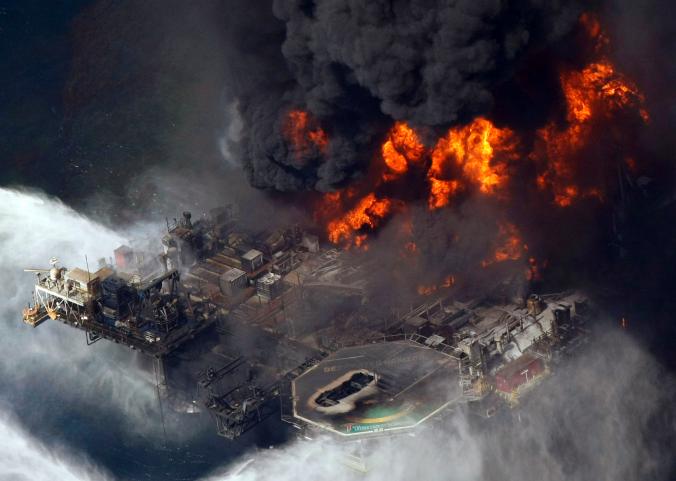 Picture of April 21, 2010 Gulf of Mexico Deepwater Horizon oil rig is seen burning.
Picture of April 21, 2010 Gulf of Mexico Deepwater Horizon oil rig is seen burning.
The Deepwater Horizon rig exploded on April 20, 2010, spilling more than 100 million gallons into the ocean and killing 11 workers.
PHOTOGRAPH BY GERALD HERBERT, ASSOCIATED PRESS
Lessons From the Past
After the Exxon Valdez spilled millions of gallons into Prince William Sound, the numbers of pink salmon returning to the region’s rivers plummeted and remained depressed for years. Pacific herring collapsed in 1993 and never came back.
In trying to grasp what happened, scientists learned that herring and salmon embryos near the spill accumulated polycyclic aromatic hydrocarbons (PAHs), toxic compounds found in oil. These chemicals, which are known to mutate DNA, visibly altered the shape and function of fish hearts in multiple lab experiments conducted over a decade.
“You have to put massive amounts of oil in water to kill an adult fish,” says John Incardona, a fish toxicologist with the National Oceanic and Atmospheric Administration’s (NOAA) Northwest Fisheries Science Center. “But an embryo doesn’t have a liver yet, so they get hammered by these compounds at incredibly small doses.”
When embryos were exposed in lab tests to high doses of PAHs, scientists reported heart failure. Those exposed to minute amounts of oil did grow into normal-looking fish—but they grew slower and often died early.
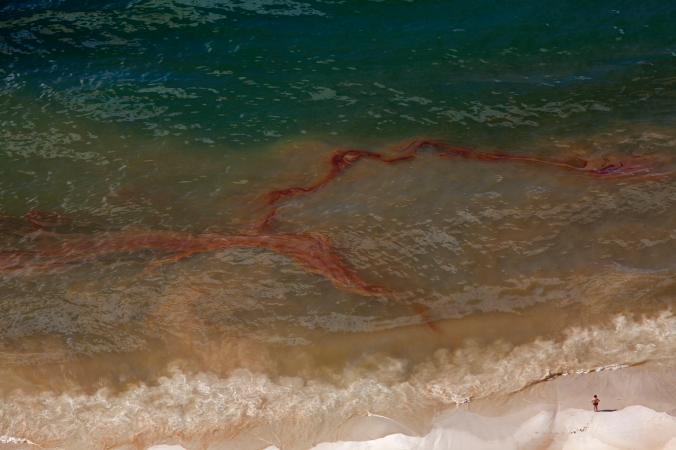 Oil from BP’s blown-out well covered the shoreline of Orange Beach, Alabama, in this photograph taken two months after the 2010 spill.
Oil from BP’s blown-out well covered the shoreline of Orange Beach, Alabama, in this photograph taken two months after the 2010 spill.
PHOTOGRAPH BY TYRONE TURNER, NATIONAL GEOGRAPHIC CREATIVE
“When we exposed pink salmon to oil and released them to the sea, survival dropped by 40 percent long, long after exposure,” says Ron Heintz, with NOAA’s Auke Bay Laboratory in Alaska.
While the drops in wild salmon and herring in Prince William Sound after the Alaska spill were complicated by other factors, many scientists see a connection: “I definitely think oil played a role,” Heintz says.
Incardona, who started his career as a pediatrician studying birth defects, wasn’t done. He began treating fish as he would human patients.
“What do we do with people to test their heart?” he asks. “We put them on a treadmill.”
He put zebrafish in tubes and measured their speed. Oil altered their hearts’ rhythms, causing them to skip beats and change their shape. Fish also swam more slowly.
When the translucent herring embryos that had been exposed to small amounts of oil also were exposed to sunlight, the creatures died even faster. Ultraviolet radiation combined with oil caused the embryos to essentially disintegrate.
“In animals that have accumulated hydrocarbons and been subjected to UV radiation, that toxicity can be enhanced—dramatically,” says Fern Galvez, a Louisiana State University biologist and toxicologist. “It can be ten times more toxic.”
The 2010 explosion on the Gulf rig offered more clues about oil’s toxicity.
No Population Impacts?
Scientists exposed many species to the oil that spilled from BP’s well. Killifish, which are food for many Gulf species, hatched later and less successfully after oil exposure.
“The implications are global.” — Nat Scholz, NOAA
Researchers also turned to big, important mid-water predators—bluefin, yellowfin, marlin, swordfish. Many of these fish spawn in spring in the Gulf, producing floating egg sacks. In lab tests on tuna, Gulf oil affected development of everything from their jaws to their spines, all stemming from damage to the heart.
For major predators spawning in spilled areas of the Gulf, “losses of early life stages were likely,” a team of scientists, including several from NOAA, concluded.
Research like this study, which was published last year, is being used by the federal government to help build a legal case that will determine what BP should pay for ecological restoration in the Gulf.
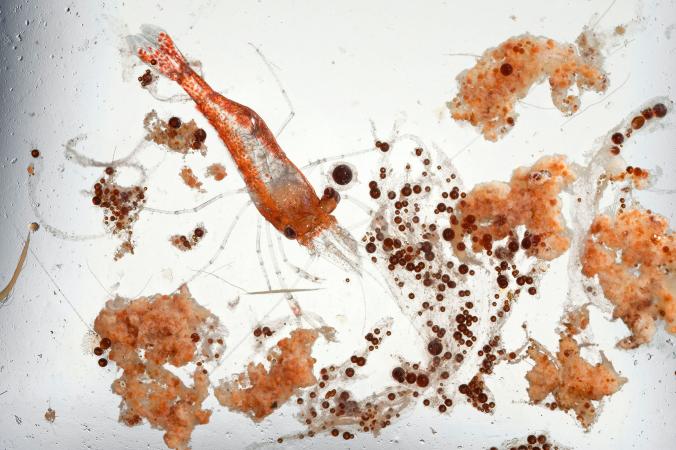 Picture of A shrimp the size of a staple swims amid dark brown globules of oil
Picture of A shrimp the size of a staple swims amid dark brown globules of oil
A shrimp the size of a staple swims amid dark brown globules of oil. Scientists say the effect of the BP spill on fish, crabs, and other marine life remains unknown five years later.
PHOTOGRAPH BY DAVID LIITTSCHWAGER, NATIONAL GEOGRAPHIC CREATIVE
BP representatives say the heart research didn’t address key questions, such as how many larval fish actually were hit by oil in the Gulf.
“The authors themselves note that it is nearly impossible to determine the early life impact to these species,” the company wrote in a statement.
A BP consultant also said too little was known about how many killifish embryos were exposed to oil for anyone to predict an impact on populations. Part of the region where Atlantic bluefin spawned, for example, was heavily oiled, but other parts were not. Plus fish populations are dynamic and capable of withstanding wide swings.
“I do not find the materials to offer a convincing prediction of population-level effects,” Walter Pearson of Stantec Consulting Services wrote in a June 2014 comment.
The scientists responded that they suspected that oil industry officials would never accept that oil had harmed an entire group of fish without “a completely connected chain of causality.”
“As a consequence, industry is unlikely to accept the findings of probable damage to fish populations from toxic chemicals, even when existing evidence is clearly consistent with such effects,” they wrote.
The findings, however, have researchers looking for impacts beyond the Gulf.
How Low Can It Go?
For starters, the Gulf spill helped reveal that heart toxicity may be universal among fish exposed to oil. Researchers now see similar patterns in every fish they test in laboratories, from Japanese sea perch to olive flounder to Australian rainbow trout.
And they’ve learned it doesn’t take much.
“The concentrations that reduce swimming performance are down at our detection limits,” Incardona says. “So now the question is: What’s the lowest concentration of oil that will cause a malformed heart?”
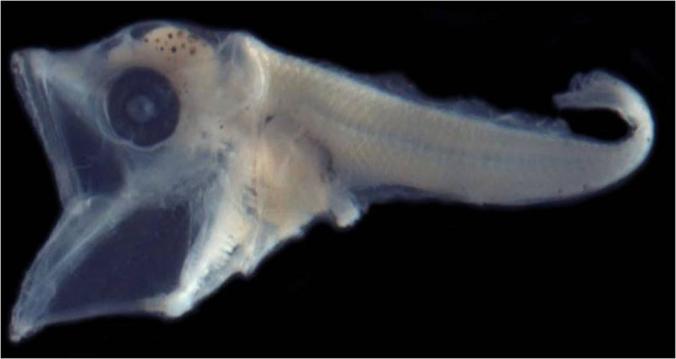 Picture of A bluefin tuna larvae
Picture of A bluefin tuna larvae
Scientists say oil can disrupt the development of baby fish, such as this bluefin tuna larva.
PHOTOGRAPH BY JOHN LAMKIN, NOAA
The question is important, scientists say, because one of the biggest threats to coastal waters is the steady drip of urban runoff as rains flush oil and other pollution off streets into rivers and bays.
“The implications are global,” says Nat Scholz, ecotoxicology manager at NOAA’s Northwest lab. “These compounds are ubiquitous. With rampant coastal development worldwide and use of motor vehicles and exhaust, and oil and grease leakage, you have lots of sources.”
“When we exposed pink salmon to oil and released them to the sea, survival dropped by 40 percent long, long after exposure.”
— Ron Heintz
NOAA’s Auke Bay Laboratory
Already, NOAA and the Environmental Protection Agency are trying to develop new strategies to reduce transport of runoff pollutants.
“The goal is to identify control measures that are inexpensive, effective, replicable, and scalable, and then get this information out to people who are dealing with stormwater issues,” Scholz says.
The research also suggests oil spills in some places could prove worse than thought.
Before the Obama administration’s recent move to open offshore oil drilling in the Arctic, a Bureau of Ocean Energy Management analysis found a spill the size of Deepwater Horizon’s was unlikely. But it also concluded there was a 75 percent chance of a significant spill over 77 years. If such a spill hit the wrong place at the wrong time, it could be felt widely.
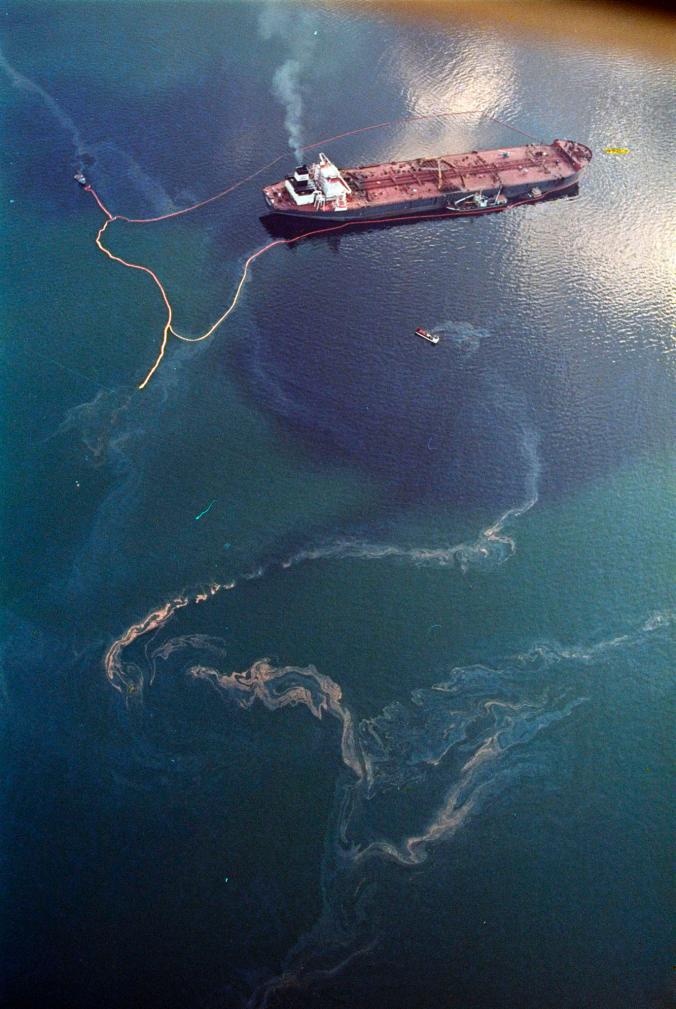 Picture of crude oil from the tanker Exxon Valdez, top, swirls in Prince William Sound
Picture of crude oil from the tanker Exxon Valdez, top, swirls in Prince William Sound
The Exxon Valdez spilled millions of gallons of crude oil into Alaska’s Prince William Sound in 1989. Scientists say lab experiments show the spilled oil had toxic effects on herring and salmon embryos.
PHOTOGRAPH BY JOHN GAPS III, ASSOCIATED PRESS
Oil in cold environments sticks around longer, Incardona says, and the Arctic’s ice-free summers offer greater potential for ultraviolet radiation to amplify toxicity for fish and wildlife.
“With that really clear water, the receding ice, those extended daylight hours, a summertime oil spill in the Arctic could be very bad,” Incardona says.
A spill that harms one Arctic species could hurt many others. “If what you eat or what eats you gets nailed, you’ll be affected,” Whitehead says. For instance, almost everything at the top of the Arctic food web—seals, polar bears, many whales—eats cod.
“If you have a spill that poses a problem with Arctic cod, that’s going to have major implications,” Heintz says.
To prepare for possible oil spills in the far north, NOAA toxicologists are teaming with Norwegian scientists who raise Arctic fish so they can test them in labs.
“We’re trying to get out ahead of the information gaps for Arctic species,” Scholz says.
